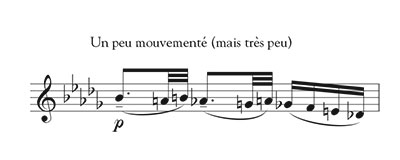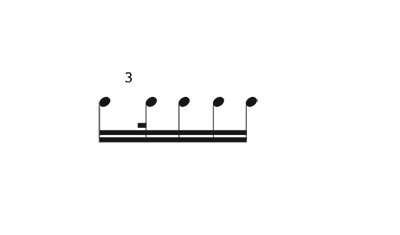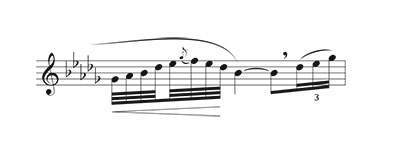Undoubtedly the best-loved flute solo from our present century is Claude Debussy’s Syrinx. This unaccompanied masterpiece was written in 1912 for Gabriel Mourey’s play Psyché, in which Syrinx was used as incidental music for a scene depicting the death of Pan. Debussy’s friend Louis Fleury gave the first performance, and the manuscript remained in his possession until his death in 1925. Syrinx was finally published in 1927 by J. Jobert in Paris.*
Most flutists are aware of the high degree of musicianship and technical control it takes to perform Syrinx. Beautiful tone, careful phrasing, delicate nuances, smooth legato, and fine intonation are all necessary to an artistic performance. But in our eagerness to “interpret” the piece and imbue it with our personal feeling, we often ignore some of the explicit notation of the composer, thereby compromising our performance. The following checklist spotlights some of the more common deviations from the composer’s text.
For those who have already studied Syrinx, I hope this will serve as a stimulus for careful review. On the other hand, if you are preparing the piece for the first time, this checklist should give you some firm guidelines for study, especially in matters of rhythmic control, which is so crucial to a good interpretation. As Austin points out in his analysis (pp. 8-9):
The melody seems like a long cadenza, a rhapsodic improvisation. But not a note of it is random… The rhythm of the melody is as intricate and peculiar and intelligible as its contour.
Measure 1
Don’t rush the 2nd beat. The Ab is too often played as a dotted 16th instead of a dotted 8th.

Don’t play a diminuendo at the end of the bar. You should offset the natural tendency to do so by hinting at a slight crescendo from the En to the Db and across the barline, being careful not to go sharp on the Db or over accent the beginning of bar 2.
Measure 2

Don’t diminish before the 32nds. Otherwise there will be too little diminuendo left for the half-note Bb.
Measure 3
Just as in bar 1, do not rush the second beat.

The natural diminuendo in beat 3 need not be resisted quite so much as in bar 1, so that the crescendo in the first beat of bar 4 will grow out of the sonority of the third bar without sounding forced.
Measure 4

The piano on beat 2 is subito. The end of the preceding crescendo is presumably about a mezzo forte. (Debussy rarely gave explicit dynamic values to ends of short crescendos when followed by a subito piano.)
The breathing comma after the Bn should be deleted if you can play from the beginning of bar 3 to the Bn of bar 5 in one breath. It is highly doubtful that Debussy furnished these printed breath markings, and most of them should be ignored. They were probably inserted by Louis Fleury, to whom the piece was dedicated.
Be sure to play an accurate triplet rhythm in the second half of beat 2 so that there is a recognizable rhythmic contrast to the second half of beat 1.
Keep the crescendo growing to the very end of the bar. The usual tendency is to diminish on the last triplet, thus spoiling the subito piano of bar 5.
Measure 5

In addition to observing the opening subito piano, note that the slur goes across the barline from bar 4.
Don’t begin the first crescendo too soon.
It is tempting to play the second half of beat 1 as a triplet because of the influence of the rising triplet figures in bar 4. Beat 1 must be in rhythm.
Although it has become customary to play the third beat considerably faster than the normal tempo and to shorten the dotted 8th rest in bar 6, this tradition is now getting so out of hand that it is beginning to sound like a parody on František Drdla’s Serenade. As a starting point for a fresh interpretation, try playing it in a more strict tempo.
Measures 6-8

Don’t play the pickup as a 32nd note, and don’t slur into the Cb, but tongue both the Ab and Cb as softly as possible.
Keep the crescendo going gradually through the Cb to the beginning of the Db (to about a mezzo forte). Do not diminish too rapidly going across the barline, so that the final diminuendo of bar 8 has a better chance of being well rationed.
If you play a French model flute, the final diminuendo can be enhanced by using the harmonic fingering for Bb: Finger low Eb, but let the left-hand second finger slightly vent its hole.
Measure 9

Although this sounds like a repetition of the opening theme, be well aware of the three elements that contrast this section from the beginning of the piece: a little faster tempo, one octave lower, and softer. Being one octave lower is an obvious contrast, but in order to take full advantage of the concomitant color change, you should be careful not to play too loudly. Flutists who have just developed a rich, sonorous low register are especially prone to show off their big sound here.
Although the tempo is a little faster, don’t rush the second beat. (My tempo preference for this section is about quarter note = 50, compared to about quarter note = 40 for the beginning.)
On beat 3, don’t raise your right-hand little finger when going from F to En in anticipation of the low Db. This spoils the tuning and quality of the En. Neither is it necessary to slide the little finger if you learn to jump it over to the Db key at the very last moment. The same observation and technique are applicable to bars 16 (beat 1), 18 (beat 1), 29 (beat 3), 30 (beat 3) and 31.
Measures 10-11

The crescendo at the end of bar 10 should follow through across the barline so that the beginning of bar 11 is strong enough (about mp) to permit a recognizable diminuendo on the third beat.
Don’t rush the third beat of bar 10 and the first beat of bar 11. This would destroy the contrasting rhythmic diminution of this passage in bar 12.
Whenever there is a grace note following the first note of a beat, as in bar 11, don’t let it disturb the underlying rhythmic flow. Although the grace note’s value is borrowed from its preceding note, don’t jump in so early that the next note has to be held longer.
Written:

Correctly played

or

Incorrectly played

or

In any case, don’t play the grace note too short. There is ample time to fit it in gracefully.
If possible, avoid the breath in bar 11 and wait until the third beat of bar 12.
While holding the Bb in beat 2 of bar 11, switch your right-hand little finger to the Db key in preparation for a smoother fingering change from Ab to Db in the third beat.
Measure 12

After the crescendo on beat 1, don’t diminish the second and third beats. Otherwise the preparation for the climactic mf of bar 13 will run aground.
The last three notes of the bar are sometimes played so slowly that they sound like normal 16ths rather than triplet 16ths, again spoiling the composer’s carefully planned rhythmic scheme, which is always balancing and contrasting the duple and triple subdivisions.
Measure 13

Two rhythmic pitfalls occur in this bar, the 32nds played too slowly, sounding like 16th triplets; or too fast, sounding like 64ths.
Be sure to keep the mf going through the first two beats (imagine a slight crescendo to offset the natural diminuendo), and don’t let the 32nds sound softer than the 8ths.
Some flutists prefer to slur the whole measure together (as they often erroneously do in bar 1 and elsewhere), but this tends to make the passage sound too glib. A soft, well-coordinated tongue stroke on the second and third beats should not disturb the legato qualities of the phrase.
Measure 14

Another grace note trap occurs in beat 1, the printed version

misplayed as

This is a very common error and has many subsequent chances for reinforcement in bars 15-19 and 31.
Measure 15

The dynamics in this bar are rather puzzling, but from careful study of similar markings in other works of Debussy, my interpretation is that the crescendo at the end of bar 14 leads into an implied mp (or perhaps an mf) on beat 1 of bar 15, which diminishes to the p of beat 2, which in turn diminishes to an implied pp. Thus the pianos on the third beat and the first beat of bar 16 would be subito pianos following the implied pp’s. Of course all of this must be done with great subtlety, without losing track of the tempo, rhythm, or legato flow.
Double check note accuracy, especially in beat 3. Also the Gb grace notes in beats 1 and 2 sometimes become unwitting G naturals because of a careless right-hand third finger that does not want to stay down after the Eb. Don’t play the grace note so fast that you can’t really hear its pitch.
Measures 16-17

After the Cédez (slowing down) of bar 15, we now have a Rubato tempo which lasts until the au Mouvt of bar 26. Bar 16 can be poco accelerando, bar 17 more relaxed, and then bar 18 in tempo. From bar 19 there is a very gradual and steady moving ahead to bar 24 (the interim metronome marking for bar 22 would be about quarter note = 66; for bar 24 about 72). Despite the overall flexibility of this Rubato section, one must not lose sight of the importance of rhythmic proportion. For instance in bar 16, the second and third beats are almost always played too fast, making this bar sound like seven equal (but rushed) 8th notes. It is the same thing in bar 18.
Antidote: Dwell on the low C of beat 2. Then fill out the crescendo nicely. Try to do without the breath at the end of the bar.
Measure 19

This bar begins with a subito piano, so don’t forget to push the previous crescendo right to the barline.
Be sure to start the crescendo of bar 19 somewhat before the third beat. This will give you a smoother change of sonority as you go from the low register to the middle register.
Measure 20

Tie over long enough from bar 19 so that you don’t convert the triplet in beat 1 to duple 16ths.
Measure 21

Compared to bar 20, this has a reverse trap, the first three notes of the second beat often being played as triplet 16ths in imitation of the legitimate triplet just before it. But in avoiding that trap, don’t fall into a worse one by playing the second beat like triplet 8ths.
Measure 22

Don’t get carried away with cadenza fever in this bar – at least not until you are absolutely sure of note accuracy. Check these notes especially: second beat Cbs and Ebbs, and third beat Gbs. Remember that the descending notes of each beat mirror exactly the ascending notes.
For the same reasons as given for bar 13, it is better not to slur the whole measure together.
Measures 23-24

In the second beat, start with the regular Eb fingering, then immediately switch to the trill fingering (second trill key).
Despite the implied accelerando, take enough time on the third beat so that the quarter note does not sound like an 8th. The same observation applies to the second bet of bar 24.
Give special attention to controlling the three grace notes leading up to the Bb fermata. The excitement of the previous build-up can cause you to play the grace notes so fast that it becomes difficult for the listener (or for you) to hear a clear three-note scale.
Debussy omits dynamic markings altogether in bars 20-24, but the performer has been given responsibility here because of the Rubato indication. The musical tensions so strongly developed in these five bars give us plenty of encouragement for a healthy crescendo, especially in bars 23 and 24. One must be careful, however, not to exaggerate.
Measures 25-26

Too many players ignore the third beat Bb and simply play the recap of the theme without Debussy’s suspenseful “extra” beat.
Observe the crescendo here (which was not indicated in the first statement of the theme). It culminates in an implied forte in bar 27, the last climax of the piece.
Measure 27

Again, the breathing comma at the beginning of this bar is highly questionable.
Doublecheck your note accuracy in the second beat. The Ebb is often played as an Eb.
Be sure to hold the third beat properly across the barline. This is comparable to the “extra” beat feeling going into bar 26.
Measures 29-30

Ration your crescendo carefully toward the Gb, but don’t let down too suddenly for the diminuendo. Some subtle changes of nuance can be explored in bar 30, but don’t indulge in a cliché echo effect. Debussy did not mark it that way.
The triple-duple rhythmic contrast is often marred here by rushing the second beat, but I have also heard a recording by one well-known player who plays the second beat so slowly that the 16ths sound like 8ths! (It was probably to compensate for the overly fast triplets of the first beat.)
Measures 31-32

Because of the risky fingering change from the low Db to the grace note Gb in the second beat, the Gb is often unclear. Slow practice with the aid of a mirror should improve your control. One tempting solution not recommended is to keep the Db key down during the entire triplet. This dulls and flattens the F and E natural. On the contrary, the little finger should get to the Eb key in time for the F, remain there for the E natural, then at the end of the E natural jump over (not slide) to the Db key as the third finger gets ready to go down. In other words, all the notes in the second beat are to be fingered normally except for the Gb, for which the little finger can be up.
So that 1. the A natural will not sound too loud, and 2. the following diminuendo will be more effective, give a tiny crescendo at the very end of the first beat.
Contrary to the admonitions given for bar 31, here you should keep the little finger on the Db key. It will not dull the A natural and G natural, but will ensure optimum legato.
Measures 33-35

Don’t diminish the Db so much that it gives the impression of being the final note, thus spoiling the dying-away effect of the final Db two bars later. Rather, release it quietly but with a slight feeling of suspense so that the listener knows there is one last phrase yet to be heard. (The same caution applies to the Db tied over from bar 30.)
The accent (marqué) is usually done by means of a sudden vibrato intensification.
Considering the long value of the B natural tied over from bar 33, the gradual slowing down of the tempo from bar 31 (En retenant jusqu’à la fin) and the Trés retenu of bar 34, it would seem that the inner pulse feeling would by now be so feeble that it would be useless to attempt a precise rhythmic rendering of the final descending whole-tone scale (five notes divided into two beats). Nevertheless, the pacing of this scale is so important – it can easily be done much too fast or too slow – that one should study it closely. It is not too difficult to feel the penta-rhythmic pulse of this bar if you establish it immediately on the first beat (the marqué accent will be a helpful stimulus), so it will be instructive to practice it first this way:

Then:

In the example immediately above, I have attempted to give a realization of the grace note that exemplifies the final sigh of resignation of this piece. By relating it to the inner penta-rhythmic pulse of the preceding bar, I believe that the proper expression can be obtained more easily. The Eb at the end of bar 34 should be diminished slightly (and quickly) in order to set off the grace note more effectively, but be careful not to let the sound actually stop at the barline.
The final Db is a very long note, so postpone your final diminuendo until about the third beat so that the sound is not lost prematurely. Keep the vibrato going as long as possible – a fairly fast, shimmering kind of vibrato that gives the impression that it is continuing into infinity.
This article originally ran in the February 1976 edition of The Instrumentalist with the following: ©1927, renewed 1954, Jobert. Paris, France. Used by permission of the publisher. Theodore Presser Company, sole representative, Canada, U.S, Mexico.
*A lengthy but fascinating analysis of Syrinx, emphasizing the details of Debussy’s compositional style, appears in William W. Austin’s book, Music in the 20th Century (New York: W.W. Norton & Co., 1966), pages 7-15.






